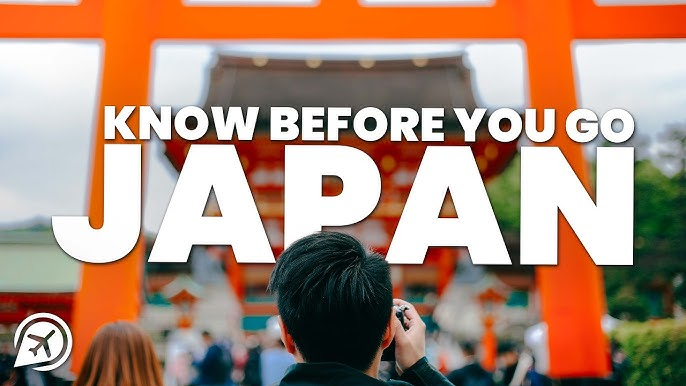Planning a journey to Japan? Wonderful choice. But before dreaming of sushi breakfasts, vibrant streets, and peaceful temples, there are a few things you should be aware of to prevent beginner mistakes and make your trip smoother.
Think of this as your straightforward guide to Japan—based on personal experience and a few embarrassing situations I wish someone had warned me about.
- Cash Is (Still) King You would think a country as technologically advanced as Japan would lean towards credit cards. Not always. Particularly outside of major cities, many restaurants, small shops, and even certain train stations require cash.
True Story: I once tried to buy a train ticket in Arashiyama, and the machine didn’t accept cards. Cue the frantic search for an ATM that took foreign cards (7-Eleven saved the day).
Suggestion: Bring yen with you or withdraw from 7-Eleven, FamilyMart, or Japan Post ATMs. Don’t rely solely on your card.
- Don’t Tip—It’s Odd Seriously. Tipping is not a part of Japanese culture. Leave money on the table, and they might chase you down the street to return it.
Instead: Show your appreciation by saying “gochisousama deshita” after a meal. This phrase means “thank you for the meal,” and locals love it when you try.
- Learn Some Important Phrases You don’t have to be fluent, but knowing how to say hello (konnichiwa), thank you (arigatou), excuse me (sumimasen), and sorry (gomen nasai) goes a long way.
Pro Tip: Download Google Translate and its Japanese language pack beforehand. It’s a lifesaver when menus look like confusing puzzles. And if you’re visiting places like Kyoto or Nagoya, where English isn’t always guaranteed, this app becomes your best companion quickly.
- Public Transport Is Amazing—But Respect the Rules The trains in Japan? Remarkably efficient. But also very quiet. Loud conversations, phone calls, or loud music? A definite no-no.
What Not to Do: I got some dirty looks for laughing too loudly with my friend on a Kyoto train. Not enjoyable.
Etiquette Basics:
- Line up neatly for trains.
- Don’t eat or talk loudly.
- Give priority seats to the elderly or pregnant individuals.
- Japan Has Seasons—And They Matter From cherry blossoms in spring to colorful leaves in autumn, Japan changes its character with the seasons. It’s not just about the weather—it’s about the experience.
Season Quick Guide:
Spring (March–May): Flowers, festivals, crowds. Tokyo’s Ueno Park and Arashiyama’s riverside paths are blooming havens.
Summer (June–Aug): Hot, humid, fireworks. Osaka’s street festivals light up the city.
Autumn (Sept–Nov): Beautiful foliage, moderate temperatures. Perfect for Kyoto’s temple walks.
Winter (Dec–Feb): Snow, hot springs, clear views of Mt. Fuji. Nagoya and the Japanese Alps sparkle with snow magic.
- Wi-Fi Isn’t Everywhere (But It’s Manageable) Unlike some countries, free public Wi-Fi isn’t guaranteed in Japan. Cafes might have it, but trains and parks? Not so much.
What to Do:
Rent pocket Wi-Fi or buy a SIM card at the airport.
Use convenience stores (7-Eleven, Lawson) as backup internet spots.
- Trash Cans Are Rare—Carry Your Rubbish Japan is incredibly clean, but trash cans are few and far between. People carry their trash home. No joke.
Lesson Learned: I walked around Tokyo with an empty coffee cup for hours because I couldn’t find a bin. Accept this reality. And always keep an extra plastic bag in your backpack.
- Convenience Stores Are Your Best Friend Forget questionable gas station food. Japanese convenience stores (konbini) like Lawson, FamilyMart, and 7-Eleven serve surprisingly good food—onigiri, bento boxes, fried chicken, and more.
Travel Tip: Getting konbini breakfast is cheaper and faster than finding a sit-down place every morning. And in cities like Osaka or Nagoya, these stores often operate 24/7.
- Dress Respectfully—Especially at Temples You don’t need to wear a suit, but Japan tends to be conservative. At temples, shrines, and traditional ryokans, avoid crop tops and very short shorts.
Bonus: Always take off your shoes when entering someone’s home, some restaurants, and temple interiors. Look for shoe lockers.
- The Rail Pass May (or May Not) Be Worth It The Japan Rail Pass used to be a guaranteed good deal. However, it’s now expensive, and depending on your plan, it might not be the best option.
How to Decide:
Traveling to multiple cities such as Tokyo, Kyoto, Osaka, Nagoya, and Mt. Fuji in one trip? It could still save you money.
Staying in just Tokyo? Skip it. Use a Suica or Pasmo card instead.
- Toilets Are High-Tech, But Not Always Japanese toilets can seem like spaceship control panels. Heated seats, bidets, music. But in rural areas or train stations, you might still find squat toilets.
Tip: Look for the western-style stall icon. And don’t worry about the buttons—most have English labels now. It’s intimidating, but also kind of fun.
- Google Maps Works Well (But Hyperdia is Better for Trains) Google Maps is fine for walking directions, but for train timings? Use Hyperdia or Navitime. They’re made for Japan’s incredibly complex transit system.
Bonus Tip: Trains are on time to the minute. Don’t expect delays. One time, I was 90 seconds late for my Shinkansen to Osaka—and I had to wait for the next one. Lesson learned: arrive early.
- Respect the Culture (Even If It Feels Different) No jaywalking. No eating while walking. No blowing your nose in public. Some rules might feel strange at first, but trust me—following them gains you respect.
Cultural Tip: Bowing is important. When unsure, bow slightly. It’s polite, it works, and it saves you from awkward handshakes.
- Bring Slip-On Shoes You’ll be removing your shoes frequently. Temples, ryokans, some restaurants, even changing rooms. Slip-on shoes make life easier. Especially in places like Kyoto and Arashiyama, where temple hopping is part of your daily plan.
- Travel Insurance Isn’t Optional Japan is very safe, but accidents happen. From canceled flights to unexpected illness, having coverage is a must. Particularly when visiting mountain regions like Mt. Fuji or doing outdoor activities.
- Japanese Etiquette Is a Unique Vibe—Embrace It
Let’s be honest: some customs might feel overly formal or even confusing at first. But when you understand the rhythm of Japanese etiquette, things click—and suddenly, you feel less like an outsider and more like a respectful guest.
Here’s what I wish I had known sooner:
Silence is important: Whether you’re in a crowded elevator in Tokyo or a bamboo forest in Arashiyama, people value quiet. Loud phone calls? Big no.
No shoes indoors means… no shoes. Not only at temples or homes. Even in some fitting rooms! I once tried on a shirt in a Kyoto boutique and was politely asked to take off my shoes before stepping in. Embarrassing, but I know better now.
Handling money matters: When paying, put your cash or card in the tray provided—never hand it directly to the cashier. It may seem formal, yes, but it’s about respect.
And speaking of respect, always return a bow, even if it seems odd. A slight nod goes a long way. It’s not about overthinking—just mirror the gesture. Simple.
Final Thought:
Go With the Flow Here’s the thing—Japan is orderly, respectful, and at times… a bit mysterious. You might get confused. You may get lost. But those moments? They frequently create the best memories.
On my initial solo journey to Japan, I ended up on the wrong subway line in Tokyo and found myself in an unknown neighborhood. Instead of panicking, I entered a small ramen shop, chatted with the owner using broken Japanese and gestures, and had one of the best meals of my life. No plan. No expectations. Simply adventure.
I also recall being in awe at the sight of Mt. Fuji, its snow-capped peak rising above the clouds like something from a dream. Or that time in Nagoya when a local family invited me in for tea after helping me find a hidden temple. These aren’t just travel highlights—they’re life highlights.
So breathe. Bow. Slurp your noodles loudly (it’s polite!). And appreciate every moment.
Have your own tips or Japan travel fails? Put them in the comments below—I’m all ears for stories and lessons learned the hard way.




